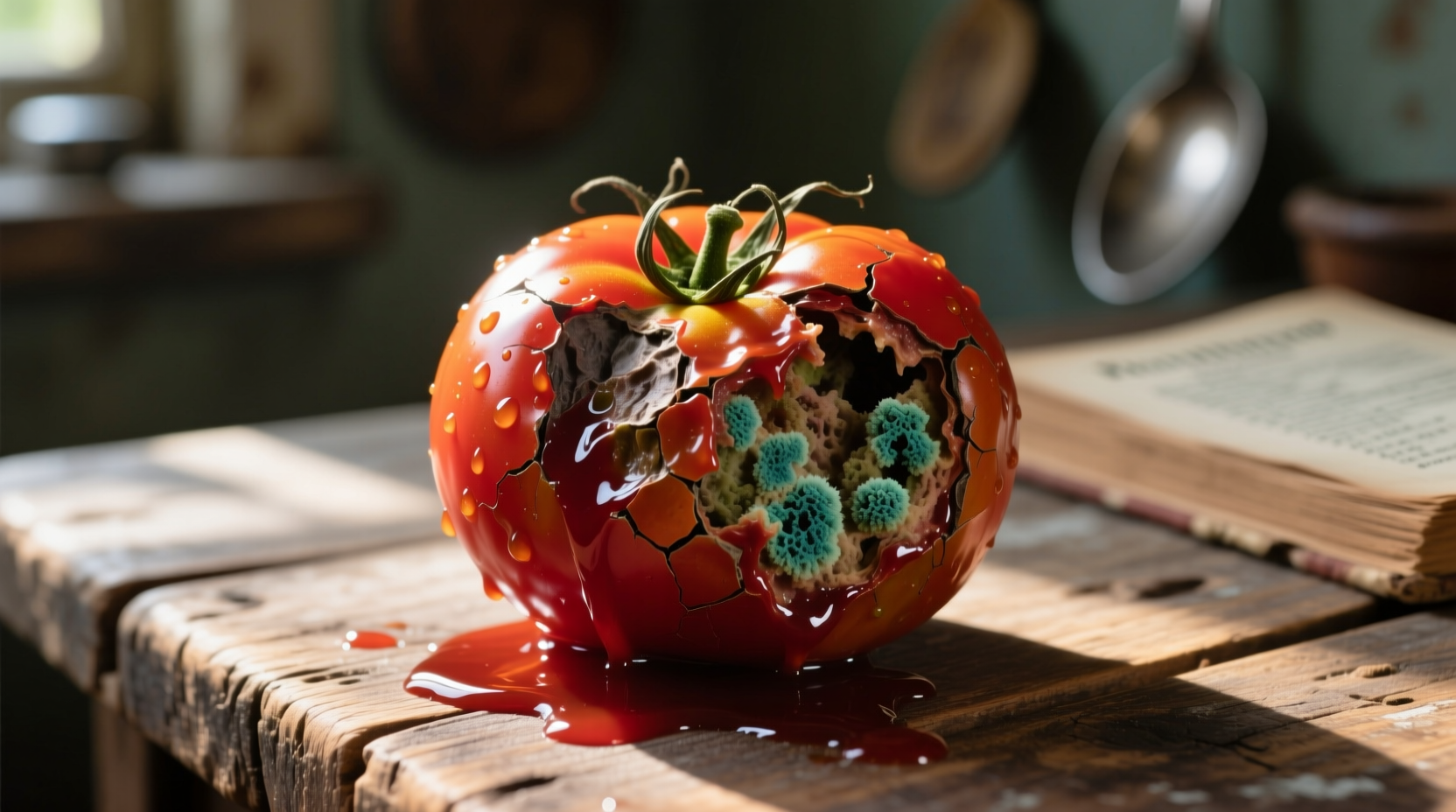Ever stared at a slightly soft tomato wondering if it's still safe to eat? You're not alone. Nearly 40% of household food waste comes from misjudging produce freshness, according to USDA data. Understanding the precise indicators of tomato spoilage protects your health and saves money. Let's explore exactly when a "rotten tomato" crosses from usable to hazardous.
Recognizing Progressive Spoilage Stages
Tomato deterioration follows predictable patterns. Recognizing these stages helps you make informed decisions about usability:
| Freshness Stage | Visual Indicators | Texture | Safety Status |
|---|---|---|---|
| Peak Freshness | Vibrant color, smooth skin | Firm with slight give | Optimal for all uses |
| Beginning Ripeness | Deepened color, minor softening | Yielding to gentle pressure | Safe for immediate use |
| Overripe | Dark spots, wrinkled skin | Noticeably soft in areas | Safe if no mold; best for cooking |
| Early Spoilage | Visible mold, deep soft spots | Wet, mushy texture | Discard entire tomato |
| Advanced Spoilage | Extensive mold, liquid leakage | Completely mushy | Immediate disposal required |
The Science Behind Tomato Spoilage
Understanding what happens as tomatoes deteriorate helps explain why certain stages remain safe while others pose risks. Tomatoes contain high moisture content (94-95%) and natural sugars that create ideal conditions for microbial growth once protective skin integrity is compromised.
According to research from the U.S. Food and Drug Administration, spoilage typically follows this progression:
- Day 1-3: Ethylene gas production increases, accelerating ripening
- Day 4-6: Cell walls break down, creating softer texture
- Day 7-8: Surface pH changes allow mold spores to establish
- Day 9-10: Mycelium networks penetrate deeper tissue
- Day 11+: Toxin-producing fungi like Aspergillus may develop

When Slightly Soft Tomatoes Are Still Safe
Not all softening indicates danger. Many home cooks unnecessarily discard tomatoes that remain perfectly safe. The critical distinction lies in identifying where softness occurs and whether protective barriers remain intact.
According to Cornell University's Food Science Department, tomatoes remain safe when:
- Softness occurs only at stem or blossom end
- No visible mold appears (white, green, or black fuzz)
- No foul odors develop (sour or alcoholic smells)
- Surface remains dry without liquid seepage
When these conditions apply, simply cut away affected areas with a 1-inch margin. The remaining flesh typically contains no harmful pathogens, as mold mycelium hasn't penetrated deeply.
Proper Storage Techniques That Extend Freshness
How you store tomatoes dramatically impacts their shelf life. Contrary to popular belief, refrigeration isn't always best. The USDA's Agricultural Research Service confirms that cold temperatures below 55°F disrupt flavor compounds and accelerate texture degradation.
Follow these storage guidelines based on ripeness:
- Unripe tomatoes: Store stem-side down at room temperature (65-70°F)
- Ripening tomatoes: Place in paper bag with banana to accelerate process
- Peak-ripeness tomatoes: Use within 2 days or refrigerate for up to 3 days
- Cut tomatoes: Always refrigerate in airtight container for up to 3 days
Creative Uses for Overripe Tomatoes
Before tomatoes reach dangerous spoilage stages, maximize their culinary potential. Overripe specimens often develop intensified flavor as sugars concentrate.
Professional chefs like those at the Culinary Institute of America recommend these applications:
- Quick tomato sauce (simmer with garlic and herbs)
- Tomato soup base (roast first for deeper flavor)
- Bruschetta topping (combine with fresh basil and olive oil)
- Smoothie ingredient (adds natural sweetness)
- Homemade ketchup or chutney
Food Safety Risks of Consuming Spoiled Tomatoes
Consuming tomatoes past safe spoilage stages introduces significant health risks. The Centers for Disease Control identifies several pathogens commonly associated with spoiled produce:
- Salmonella: Causes severe gastrointestinal illness; tomatoes were implicated in a 2008 outbreak affecting 1,300 people
- E. coli: Can develop in damaged tissue; particularly dangerous for children and elderly
- Mold toxins: Certain fungi produce mycotoxins that survive cooking temperatures
When in doubt, follow the FDA's clear guidance: "When mold appears on high-moisture foods like tomatoes, the roots likely extend deeper than visible. Discard the entire item."
Avoiding Common Misconceptions
Several persistent myths lead to unnecessary waste or unsafe consumption:
- Myth: "Cutting away moldy parts makes tomatoes safe"
- Reality: Mold roots penetrate deeper than visible; FDA recommends complete disposal
- Myth: "Refrigeration always extends tomato shelf life"
- Reality: Cold temperatures damage flavor compounds; best for only fully ripe specimens
- Myth: "All soft tomatoes indicate spoilage"
- Reality: Softening is natural ripening; only becomes dangerous with mold or foul odors











 浙公网安备
33010002000092号
浙公网安备
33010002000092号 浙B2-20120091-4
浙B2-20120091-4